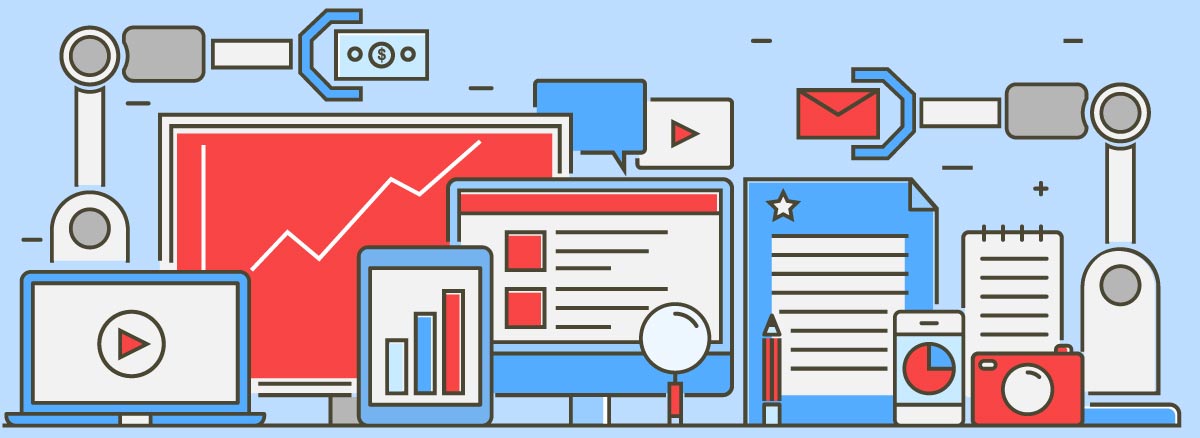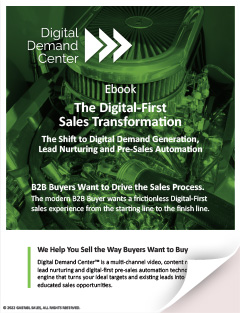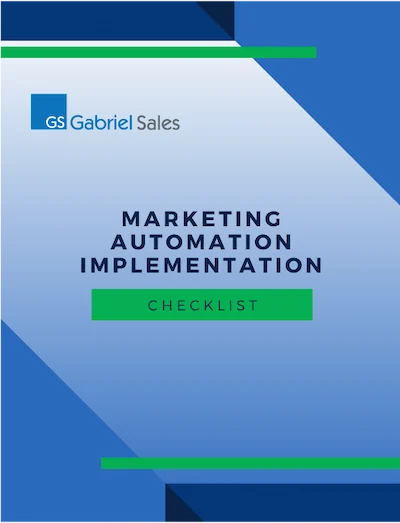
Businesses that use marketing automation to nurture prospects experience a 451% increase in qualified leads. (Propeller)
B2B marketers say the number one benefit of marketing automation is the ability to generate more qualified leads (Pepper Global). They experience these great results because, marketing automation allows you to educate buyers, build trust, and stay in touch with prospects as they search for solutions to their problems. However, while more than 60% of marketers use email to stay in touch with their prospects, only 13% use marketing automation tools so they put in some of the effort but only get a fraction of the results. They also miss out on early stage leads, since marketers using marketing automation generate twice as many leads than those who just use one off blast emails. It’s statistics like these that spurred us to share some of Gabriel Sales’ automation best practices that have benefitted our firm and our clients.
Marketing automation is not necessarily difficult, but it does require a bit of a learning curve and some planning. Here are eight best practices we use that will ensure you’re marketing automation will be used wisely.
Start with a Strategy
Without a strategy, your marketing automation tool will inevitably become an ordinary email tool, blasting one-off messages and newsletters. The process of creating a strategy requires defining your value proposition, targeting your audiences, outlining the buyer personas of your ideal customers and mapping your buyer’s journey to your sales process. This allows you to tell your story, establish thought leadership and build trust with your potential buyers without the expense of sales reps doing this one customer at a time. A DemandGen study found that 95% of buyers consider content as trustworthy (and in some cases at early stages more trustworth then sales reps) when evaluating a company and its offerings.
Framework to Tell a Powerful Sales Story with Simple Messages
A critical part of the strategy will be a series of simple messages that tells your sales story in a way that resonates with your buyer’s needs. This message framework will anchor your marketing efforts. This framework will deliver the right message at the right time based on where your buyer is at specific stages their buyers journey. As the table shows, there are different pieces of content topics and different types of media that work best for certain stages. While educating your potential buyers about your perspective on challenges they face in the marketplace, who you are, and how you may be able to solve their problems, your content will be organized in a systematic way to help them understand if you are the right fit to help them solve their challenges . This builds trust with buyers looking to buy and keeps your brand and your solutions top of mind, for those not yet ready to purchase with helpful educational content.
Use Lead Nurturing to Create Opportunities
On average it takes, on average between 7 and 13 touches by both sales and/or marekting before a sale is made. This does not count the 47% of buyers who want to view 3-5 pieces of content before they even want to engage with a sales rep. (DemandGen). All this takes time. And if you rely on sales reps to carry the load it can also take a significant amount of money. For those leads that already know about your solution, but aren’t yet ready to buy, lead nurturing allows you to stay top of mind through offering educational and thought-leadership content about industry trends and developments without the expense of a sales rep. Establishing thought-leadership is critical to an overall effective cost of sales percentage, since 96% of B2B buyers want content with more input from industry thought leaders which includes the company’s selling solutions that solve their problems (Demand Gen Report, 2016). Companies that excel at lead nurturing generate with educational thought leadership generate 50% more sales ready leads at 33% lower cost (Source: Forrester Research).
Integrate Social into Your Distribution Network
While marketing automation is associated with email marketing, modern automation tools are now easily connected to help you publish your content to additional networks in social media. That said, those channels are merely that, distribution outlets where it exposes your content to additional buyers so you can educate and build trust with your audience in additional areas across the web. If you make the investment in content it also makes sense to share that content in social media. Blog articles are leveraged by your automation platform to generate and score leads by educating and building trust. But since you already have the content you can post it to social media to solidify a relationship with your leads and to make additional buyers aware of your solution.
Use Lead Scoring to Identify Who’s Engaging
Lead scoring is the least used feature by most businesses but it is the most critical for small and mid sized companies to increase productivity and lower their cost of sales. Lead scoring is the ability to figure out where someone is in their buying process and when they are getting actively interested in purchasing. Lead scoring allows sales and marketing to quickly flag who should be getting more attention from higher-end sales reps. Lead scoring will generate more revenue because better leads (buyers with high scores that are ready for sales interaction) will bubble to the top and be pritorized for you sales team, allowing your sales team to contact your most potential buyers at the right time. Lead scoring saves you money because leads with low scores that are not yet ready to buy, can be managed and developed by less expensive reps or in some case just by nurturing with marketing automation during their early education stages of your sales cycle. Lead scoring works. 68% of top marketers report lead scoring as the most responsible feature for improving thedirect revenue contribution of their content marketing efforts (Lenskold Group).
Integrate your CRM to Capture Lead Data
Capturing data and valuable information about your buyers is one of the key drivers to help you drive sales. Marketing automation allows you to capture both key sales and marketing metrics. When you have collected this information in your CRM system you sales reps will have direct access to it. This allows your sales reps to easily organize and sort prospects by any number of criteria including, points accumulated, predict location in the sales funnel/buyer’s journey and to see what educational content the buyer has consumed. This data allows you to sort buyers and then to sell to them more effectively because they will have a jump start on their level of education and business needs.
Use Data to Improve How Your Target Markets
You can learn a lot about your target audience by measuring the people who are engaging with your content through your website and emails. To better understand the interactions you can split them into two data categories, explicit and implicit. Explicit data tells you who’s volunteered information to you via web forms, events or other interactions such as phone calls. Implicit data measures online behavior such as emails opened, click-throughs, form submissions, and downloads of your marketing collateral. If an activity is predictive of buying the lead can be scored appropriately and can be highlighted in your CRM. In many cases you can send real-time alerts to sales reps once a prospect reaches a certain point threshold or if a certain activity takes place. And timing is everything. In some types of sales 35-50% of all sales are won by the vendor that responds first (InsideSales.com).
Keep it Simple
Many SMBs we talk with say they haven’t made the leap to real marketing automation yet because they believe it’s too difficult. And while successful marketing automation involves many moving parts – contact us forms, downloadable assets, social and CRM integration, lead scoring, etc. – it’s important to start small and slow, while always keeping the end goal of the purpose of marketing automation top of mind. And the ultimate point of marketing automation is to put more sales qualified opprotunities into the hands of your closers. Decide on your goals for each campaign and the few KPIs to measure your success and design accordingly. Three simple KPIs to start with are:
- Contact volume.Automation helps marketers manage greater lead and prospect volume with more efficiency and effectiveness. So, it’s important to keep an eye on how many contacts, prospects and leads are engaging with your content to better understand where they are in the buyer’s journey and if there are any actions to be taken.
- A common goal is to better move contacts through your buyer’s journey and into your sales reps’ funnels, and track progress to identify what content is working and what’s not. Measure how campaigns impact MQLs, SQLs, and unsubscribes: are your campaigns better qualifying leads, improving the marketing-to-sales lead delivery volume, generating deals that are actually interested and helping nurture leads and prospects not yet ready to buy?
- Track engagement – email opens, click-throughs, website visits, shares, etc. – to identify the most effective messages and content that moves the needle with your audiences. Tracking engagement also allows you to identify the most active contacts and whether they need attention from sales.
Keeping it simple will only require you to focus on the buyers and purchase influencers you want to engage with right now. There are all sorts of advanced features and complex segmentation that is possible but this is a distraction in the short term. When you are just getting started we recommend that you leave the segmentation, tagging, etc. for later campaigns, once you’ve warmed up your audience with your educational, trust-building content.
No matter how you slice it, the move to marketing automation is growing and will be a requirement to compete for sales successfully in the next several years. Currently, 67% of marketing leaders use a marketing automation platform, while over the next two years, an additional 21% of marketing leaders plan to use a marketing automation platform (Salesforce “State of Marketing” 2017). Those numbers are not surprising because marketing automation works and saves time and money for organizations that leverage the technology to their advantage – 80% of marketing automation users saw their number of leads increase, and 77% saw the number of conversions increase by 2X over the first 18 months of implementing a platform (VB Insight “Marketing Automation, how to make the right buying decision” 2015). It’s no wonder, 91% of the most successful users agree that marketing automation is “very important” to the overall success of their marketing across channels (Marketo & Ascend2).
About Us
Gabriel Sales specializes in helping SMBs and Startups grow business with modern sales and marketing operations. Our team can augment gaps in your existing sales and marketing operations or we can be leveraged for full service campaigns that include:
- Integrated Sales and Marketing Strategies
- Database Research and Targeting
- Automation and CRM Systems Best Practices
- Systems Implementation
- Inbound Lead Generation
- Outbound Lead Generation and Lead Scoring
- Sales Qualification
- Closing
To learn more about how we can help you grow your business (or decide if we are the right fit for you), we invite you to visit our page that details our integrated approach to sales and marketing outsourcing. Or feel free to contact us for free initial consultation and discovery session to see if our approach is the right fit to help you hit your revenue targets.




